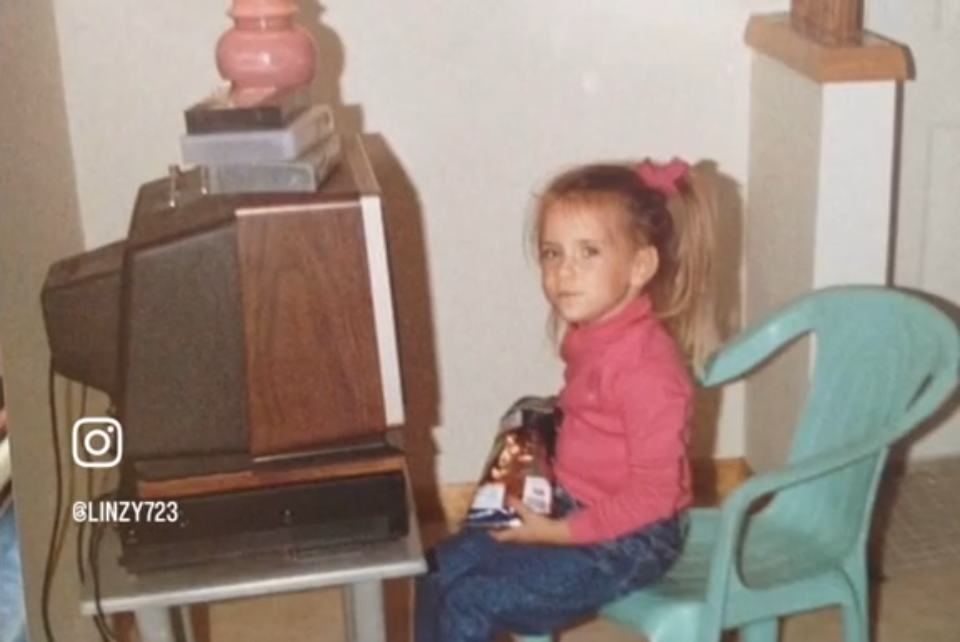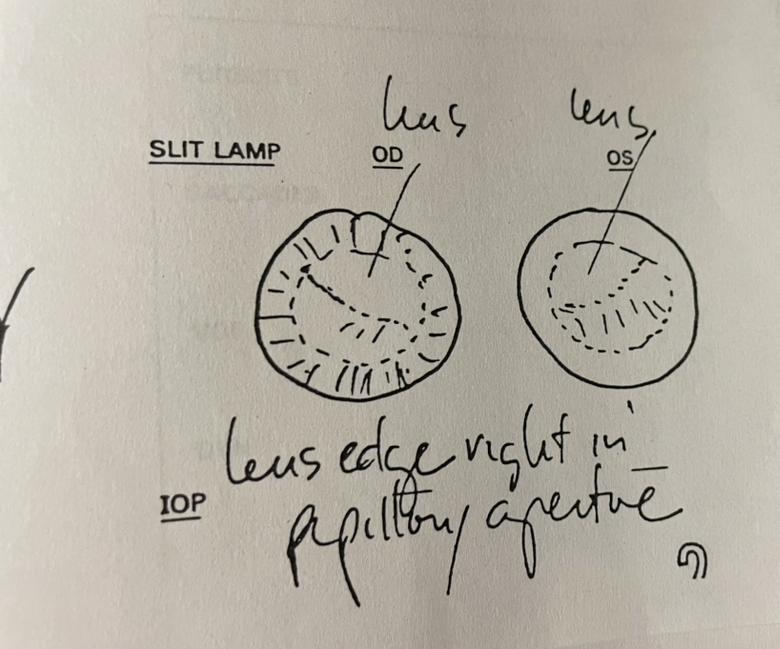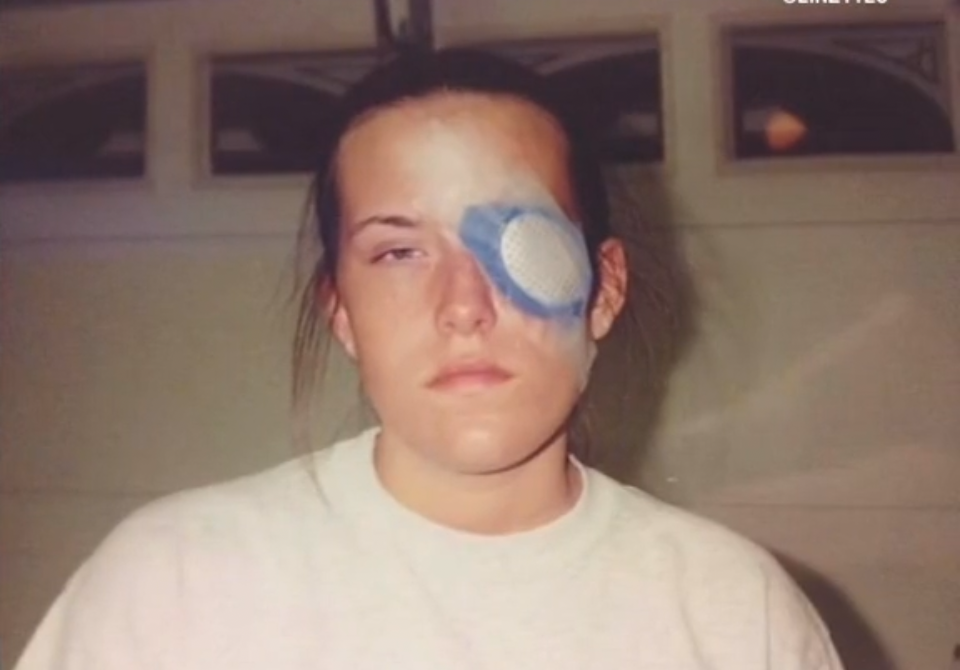
Linzy Brown’s story of life with Marfan syndrome is deeply connected to her eyes and heavily influenced by the medical era in which she was growing up. Her guest blog tells her experiences in her own words. We are grateful for Linzy’s volunteerism in West Virginia.
ADVISORY: portions of this story describe and depict medical situations/procedures in detail.
My issue was first noticed when I went to the circus in 1989. We didn’t have terrible seats, lower level. My cousin was pointing things out and when she got to the elephants, I saw none. Around the same time, I put on my aunt’s glasses and screamed out “I can see.” That’s when they knew something wasn’t right.

I was always running into things and falling but that was just chalked up to being a clumsy toddler. I always sat extremely close to the TV, like within inches. Family would just keep telling me to move back because that would ruin my eyes (ironic now).
I live in West Virginia so when mom took me to three different doctors here, they could see that the lens was dislocated but didn’t have the technology or knowledge to do anything about it. I was born with dislocated lenses in both eyes so badly that the bottom of my lens was in the center of my pupil. We were referred to [a doctor] at Duke University. He explained everything and that the only option would be to remove the lenses. Not only were they dislocated but also sitting at angles that [were] not safe for my retina or cornea. The left eye actually ended up being classified as emergency surgery. They suggested getting a second opinion to make my family feel better as this was crazy news to accept. Second opinion came from University of Pittsburgh, and they were in full agreement the lenses would have to come out.
We went back to Duke University when I was four years old and had both lenses removed in 1990. The word “Marfan” had been mentioned a few times in records but not actually verbalized – until Dr. Buckley did. He explained everything before surgery. My mom did all the research she could but at the time there was really not a great amount of information available. Because my face was not fully developed, Duke University opted to not replace the lenses at that time stating that it shouldn’t be done until adulthood at full development.
For 11 years I had no lenses in my eyes, so my contacts and glasses were extremely strong and thick. Yes, that’s right, I said contacts for 11 years. Meaning I wore contacts at the age of four. This was unheard of at the time and still isn’t common. This also meant that Sunday nights at my house were extremely challenging for a few years.
Just picture at least two people holding a four-year-old…another person holding their head still while yet another inserted and/or removed contacts from both eyes. It may sound dramatic, but that was just life for us. It was just what had to be done and we made the best of it. It is also of note that my specific contacts were meant to be worn for a week at a time because they were Silicone Hydrogels. The maintenance was also very different from anything we know now. If you’ve ever worn contacts for more than a few days, you know how the contacts basically stick to your eyes like glue. Now, think 7 days at a time for 11 years. The suction literally had to be broken in order to remove them. This being said I quickly learned how to insert and remove my own contacts making it easier on everyone.
My contacts had to be specially ordered because they were so uncommon back then and my prescription was so high. The crystalline lens inside the eye is what focuses your vision and also allows your vision to change from distance to near pretty rapidly, called accommodation. I didn’t have those. I didn’t have the largest structure in the eye. This also meant I didn’t have the type of stability needed to strengthen the eye, leading to bilateral amblyopia.

When I didn’t have contacts in or glasses on all I could see, literally, was color and light. I could not tell you from vision alone who was standing one foot in front of my face. [Right] is a picture of my glasses at age 5 or 6. You can see why I wouldn’t want to wear these to school or anywhere else. Not only were they extremely heavy and thick but it took Coke bottle glasses to the next level. These glasses also had bifocals in them so I stayed off balance and dizzy with them on.
During these years, I had to be very careful not to lose a contact because they were so expensive and hard to get. We’re talking around $325 for a pair that needed changed out every three months, and this was in 1990. I had to wear glasses with bifocals along with these contacts. That type of caution meant that anytime I was in the pool, goggles had to be worn and splashing was not allowed. There were some other modifications that had to be made throughout the years but nothing life-changing. Until 2001.
My Optometrist informed me that I needed to be seen by a surgeon because I was forming ulcers in my eyes from wearing contacts for so long. Also, they were discontinuing my contacts because there were not enough people wearing them at that time to justify production. This of course [meant] surgery was needed, again. Remember, Duke University said in 1990 that I needed to wait to have surgery until my face was fully developed. In 2001 I was 15 years old so of course that was not the case. After careful debate the only decision was to get lens implants done in both eyes.

Nowadays when you hear the term “lens implants” you think simple cataract surgery, in and out, no biggie. That was not the case for me. In 1990, there was not enough technology and information on this type of condition or procedure to know that you should only take the lens out. Your lens sits in a pocket/ capsule. In normal cataract surgery they simply cut a tiny little slit, pull out the old lens, fold the new one and put it in place. Typically no stitches are needed in this procedure and healing time is very quick. However, since I didn’t have the pocket my lens was supposed to sit inside, my surgery was going to be way more complicated. They had to physically sew a pocket into my eye and then proceed with implanting the lens into said pocket.
I was in ninth grade at the time. I missed the entire second semester of ninth grade and had to do home… schooling. This was not only because of two major surgeries but also [because] I could not wear contacts for a month before each surgery, meaning I would have to wear these glasses to junior high school. Pretty traumatic and difficult. Both surgeries went well. Healing time was slow but it got there. My implanted prescription strength was 25.5 and 26. I also still needed glasses with bifocals.
Now, fast forward to the year 2013. On June 4 I woke up with pain in my right eye. I went to work, thought it would go away but by lunch time it was worse so I went to the eye doctor. He could not find anything wrong. By the next day the pain was so intense that I was vomiting all day. I went back that night as an emergency visit and still, he found nothing. He put me on a few different eye drops, one of which was a dilation drop and said, “let’s see what happens.” July 13, I woke up to my left eye hurting as well. This time I went straight back to the doctor. Again, he found nothing and added the same regimen to the left eye as well. Mind you, not only was there pain constantly but my vision suffered drastically.
After dealing with constant dilation and wearing sunglasses pretty much 24/7, something had to give. We did many, many tests locally with different doctors and still found nothing. I then took it upon myself to contact Duke University and make an appointment with them. The doctor that did my surgery in 1990 was still practicing, however only seeing children. Since he knew my history and was a huge part of it, he agreed to see me. After several more tests, an ultrasound revealed that my lenses had moved out of place and were tilted pretty drastically again. At that point it seemed like an a-ha moment, and clearly I needed surgery again. I was informed years before this that the stitches used in my eyes only had a life span of 10 to 15 years, so we had been keeping close attention to the stitches breaking and loosening through time. Thankfully, that meant that this wasn’t as huge of a shock when I found out that the lenses had moved again.
September 23, 2013 I had another eye surgery on my right eye to reposition that lens. Once they got into surgery they ran into many other issues therefore making the surgery much longer than anticipated and way more complex. They also had a retinal surgeon in the operative room who had to perform a vitrectomy. Basically, all the debris from the surgery had collected in the vitreous fluid in front of the retina and had to be fixed.
The healing time was in no way quick or on anyone’s timeline. The first night post op was horrible. Imagine having lots of fresh stitches in your eyeball and [vomiting] countless times throughout the night. That type of pain is the 10 on my personal pain scale. I had to be monitored locally multiple times between being seen again for follow up at Duke University at one month post op.
I was initially scheduled to have my left eye repositioned as well one month later, however follow-ups revealed that surgery did not help at all. Sure, it fixed a little bit of the displacement, but it did not help the pain or the vision. The operative note even stated ‘surgery had to be discontinued due to the risk of causing more harm. The lens remains out of place and further surgery is eminent.’ I have continued to have every test imaginable on the eyes, brain and even a spinal tap.

On January 3, 2023 I had a miserable migraine. It was slightly different and more intense than most but still a migraine. The next morning when I looked in the mirror my right pupil was not correct. As a rule, pupils should be equal, round and reactive and mine was not. It was slightly less reactive to light but larger than the left and also misshaped. My vision was also more distorted than normal. I called my eye doctor who instructed me to go to the ER and be checked for a stroke. I did. Most imaging was unremarkable and showed no signs of stroke. Wonderful. But there was no answer for the pupil difference.
Even now, February 2025, we are still at a loss for answers. Since 2013, I have seen doctors at Cleveland Clinic, Cincinnati Eye Institute, Duke University, West Virginia University and a plethora of local doctors. There are some things we know as fact: both lenses are still displaced and tilted, I have amblyopia in both eyes, I still have constant pain, my vision fluctuates daily but always remains terrible, my retina and cornea are decent at very best, I have no depth perception AT ALL, my peripheral vision is almost non existent, etc. and also my right pupil remains larger than the other and is still misshaped. We know I will without doubt need more surgeries. As of now it is kind of a game of “how bad does it need to get before the benefits of surgery would outweigh the risks?” No one knows that answer.
I still have no idea what caused the sudden snowball effect in 2013. I have since just [come] to terms with the fact that it must be Marfan-related and that is that. It’s fine with me as long as it’s something. All of these other illnesses and issues that I’ve had throughout my years, finally came into perspective and all the dots started connecting. I didn’t just have all of these weird, unconnected things, I had Marfan Syndrome. For those of us with chronic illnesses, a diagnosis is not always a bad thing, it can be very validating. Validation often makes us feel less alone. It was an answer. It was a name. It was me. It is me!
My first college degree was an Associate’s in Medical Assisting…several years later, I started working in an eye doctor’s office. During my interview I was asked the question “Do you think you would be able to teach other people how to insert and remove contacts?” That’s really laughable knowing my history. I thus informed them and explained how much I had been the person in the chair and that I totally understood that side of things. Of course, I got the job. I have since learned an abundance about the human eye. At the time, my eyes were somewhat stable and it was just interesting for me to learn all of this. Little did I know, only a few years later I would need this information to decode what doctors were really saying and were really putting in their notes…[Now,] I always get all of my medical records and I suggest you do the same. If you’re not your own health care advocate, who will be?
Sure, I may have a potentially life-threatening disorder but there’s always a silver lining. At the time of medical assisting school, I didn’t really have a passion for it at all, but looking back, I’m so glad that I did it. I try to think of it as a blessing that I have Marfan Syndrome. I have been able to help many with just my story and knowledge. That makes all the struggles a little easier to swallow. I could be just another average Joe that has it and doesn’t understand anything about it, or even know they have it. Thankfully, I do understand a great deal about what is going on in my own body and exactly what to ask for and how to best make sure [my medical care is on target].
Marfan Syndrome is so rare and unheard of to the general public. Even doctors for that matter. Providers learn so little about the condition in school and then because it is so rare, most don’t want to learn more unless it is out of necessity. The vast majority of healthcare providers I have ever seen know “tall and skinny with heart problems.” This is not the only standard anymore. It’s a syndrome because everyone is affected differently, even in the same family.
Let’s change this. Let’s educate everyone around us. Let’s scream it from the top of the mountain. If only one person will listen, we did our job.

The Marfan Foundation is a nonprofit organization that saves lives and improves the quality of life of individuals with genetic aortic and vascular conditions including Marfan, Loeys-Dietz, and Vascular Ehlers-Danlos syndromes. Our vision is a world in which everyone with genetic aortic and vascular conditions can live their best life.
